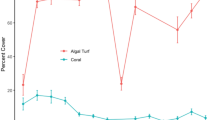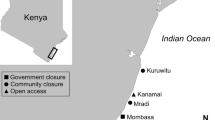Summary
When the common sea urchin Diadema antillarum was removed from a 50 m strip of reef in St. Thomas, US Virgin Islands, cover of upright algae and the grazing rates and densities of herbivorous parrotfish and surgeonfish increased significantly within 11–16 weeks when compared to immediately adjacent control areas. Sixteen months after removal, Diadema had recovered to 70% of original density, abundance of upright algae no longer differed between removal and control areas, and the abundance and grazing activity of herbivorous fish in the removal was approaching equivalence with control areas. On a patch reef in St. Croix that had been cleared of Diadema 10–11 years earlier (Ogden et al. 1973b), urchins had recovered to only 50–60% of original density. This reef still showed significantly higher rates of grazing by fish and a significantly greater density of parrotfish and surgeonfish than a nearby control reef where Diadema densities had not been altered. These results indicate that high Diadema densities (7–12/m2 for this study) may suppress the densities of herbivorous fish on Caribbean reefs.
Similar content being viewed by others
References
Bailey TG, Robertson DR (1982) Organic and caloric levels of fish feces relative to its consumption by coprophagous reef fishes. Mar Biol 69:45–50
Bakus GT (1969) Energetics and feeding in shallow marine waters. Int Rev Gen Exp Zool 4:275–369
Bernstein BB, Williams BE, Mann KH (1981) The role of behavioral responses to predators in modifying urchins' (Strongylocentrotus droebachiensis) destructive grazing and seasonal foraging patterns. Mar Biol 63:39–49
Birkeland C (1977) The importance of rate of biomass accumulation in early successional stages of benthic communities to the survival of coral recruits. Proc 3rd Int Coral Reef Symp, University of Miami, Miami, Florida, USA, pp 15–21
Breitburg DL (1984) Residual effects of grazing: inhibition of competitor recruitment by encrusting coralline algae. Ecology 65:1136–1143
Brown JH, Davidson DW (1977) Competition between seed-eating rodents and ants in desert ecosystems. Science 196:880–882
Brown JH, Reichman OJ, Davidson DW (1979) Granivory in desert ecosystems. Ann Rev Ecol Syst 10:201–227
Carlisle JG, Turner CH, Ebert EE (1964) Artificial habitat in the marine environment. Calif Dep Fish Game Fish Bull 124
Connell JH (1983) On the prevalence and relative importance of interspecific competition: evidence from field experiments. Am Nat 122:661–696
Cowen RK (1983) The effect of sheephead (Semicossyphus pulcher) predation on red sea urchin (Strongylocentrotus franciscanus) populations: an experimental analysis. Oecologia 58:249–255
Davidson DW, Brown JH, Inouye RS (1980) Competition and the structure of granivore communities. Bio Science 30:233–238
Ebersole JP (1977) The adaptive significance of interspecific territoriality in the reef fish Eupomacentrus leucostictus. Ecology 58:914–920
Hay ME (1984) Patterns of fish and urchin grazing on Caribbean coral reefs: are previous results typical? Ecology 65:446–454
Hay ME, Colburn T, Downing D (1983) Spatial and temporal patterns in herbivory on a Caribbean fringing reef: the effects on plant distribution. Oecologia 58:299–308
Hoek C van den, Breeman AM, Bak RPM, van Buurt G (1978) The distribution of algae, corals, and gorgonians in relation to depth, light attenuation, water movement, and grazing pressure in the fringing coral reef of Curacao, Netherlands Antilles. Aquat Bot 5:1–46
Keller BD (1983) Coexistence of sea urchins in seagrass meadows: an experimental analysis of competition and predation. Ecology 64:1581–1598
Lessios HA, Glynn PW, Robertson DR (1983) Mass mortalities of coral reef organisms. Science 222:175
Lewis SM (1984) The role of herbivory in the organization of tropical reef communities. Ph.D. dissertation, Duke University, USA
Low RM (1971) Interspecific territoriality in a pomacentrid reef fish, Pomacentrus flavicauda Whitley. Ecology 52:648–654
Lubchenco J, Menge BA, Gaines SD, Ashkenas LR, Lucas J, Turner T (1984) The relative contributions of competition and predation in maintaining dominance by crustose algae in a tropical rocky intertidal community. Bull Ecol Soc Am 65:75
Menge BA, Lubchenco J (1981) Community organization in temperate and tropical rocky intertidal habitats: prey refuges in relation to consumer pressure gradients. Ecol Monogr 51:429–450
Myrberg AA, Thresher RE (1974) Interspecific aggression and its relevance to the concept of territoriality in reef fishes. Am Zool 14:81–96
Ogden JC (1976) Some aspects of herbivore-plant relationships of Caribbean reefs and seagrass beds. Aquat Bot 2:103–116
Ogden JC, Abbott DP, Abbott I (1973a) Studies on the activity and food of the echinoid Diadema antillarum Phillippi on a West Indian patch reef. Special Publication 2. West Indies Laboratory of Fairleigh Dickinson University, Christiansted, St. Croix, U.S. Virgin Islands
Ogden JC, Brown RA, Salesky N (1973b) Grazing by the echinoid Diadema antillarum Phillippi: formation of halos around West Indian patch reefs. Science 182:715–717
Paine RT (1966) Food web complexity and species diversity. Am Nat 100:65–75
Potts DC (1977) Suppression of coral populations by filamentous algae within damselfish territories. J Exp Mar Biol Ecol 28:207–216
Randall JE (1961) Overgrazing of algae by herbivorous marine fishes. Ecology 42:812
Randall JE (1963) An analysis of the fish populations of artificial and natural reefs in the Virgin Islands. Caribb J Sci 3:31–47
Randall JE (1965) Grazing effects on seagrasses by herbivourous reef fishes in the West Indies. Ecology 46:255–260
Robertson DR (1982) Fish feces as fish food on a Pacific coral reef. Mar Ecol Prog Ser 7:253–265
Robertson DR, Lassig B (1980) Spatial distribution patterns and coexistence of a group of territorial damselfishes from the Great Barrier Reef. Bull Mar Sci 30:187–203
Robertson DR, Polunin NVC (1981) Coexistence: symbiotic sharing of feeding territories and algal food by some coral reef fishes from the Western Indian Ocean. Mar Biol 62:185–195
Robertson DR, Sheldon JM (1979) Competitive interactions and the availability of sleeping sites for a diurnal coral reef fish. J Exp Mar Biol Ecol 40:285–298
Robertson DR, Polunin NVC, Leighton K (1979) The behavioral ecology of three Indian Ocean surgeonfishes (Acanthurus lineatus, A. leucosternon and Zebrasoms scopas): their feeding strategies, and social and mating systems. Environ Biol Fishes 4:125–170
Robertson DR, Hoffman SG, Sheldon JM (1981) Availability of space for the territorial Caribbean damselfish Eupomacentrus planifrons. Ecology 62:1162–1169
Russell BC, Anderson GRV, Talbot FH (1977) Seasonality and recruitment of coral reef fishes. Aust J Mar Freshw Res 28:521–528
Sale PF (1977) Maintenance of high diversity in coral reef fish communities. Am Nat 111:337–359
Sale PF (1978) Coexistence of coral reef fishes—a lottery for living space. Environ Biol Fishes 3:85–102
Sale PF (1980) The ecology of fishes on coral reefs. Oceanogr Mar Biol Ann Rev 18:367–421
Sammarco PW (1980) Diadema and its relationship to coral spat mortality: grazing, competition, and biological disturbance. J Exp Mar Biol Ecol 45:245–272
Sammarco PW (1982) Echinodi grazing as a structuring force in coral communities: whole reef manipulations. J Exp Mar Biol Ecol 61:31–55
Sammarco PW, Williams AH (1982) Damselfish terrioriality: influences on Diadema distribution and implications for coral community structure. Mar Ecol Prog Ser 8:53–59
Sammarco PW, Leviton JS, Ogden JC (1974) Grazing and control of reef community structure by Diadema antillarum (Phillippi) (Echinodermata: Echinoidea): a preliminary study. J Mar Res 32:47–53
Schoener GD (1983) Field experiments on interspecific competition. Am Nat 122:240–285
Sheehy DJ (1982) The use of designed and prefabricated artificial reefs in the United States. Mar Fish Rev 44:4–15
Smith CL (1978) Coral reef fish communities: a compromise view. Environ Biol Fishes 3:109–128
Stephenson W, Searles RB (1960) Experimental studies on the ecology of intertidal environments at Heron Island. Aust J Mar Freshw Res 11:241–267
Talbot FH, Russell BC, Anderson GRV (1978) Coral reef fish communities: unstable, high-diversity systems. Ecol Monogr 48:425–440
Thresher RE (1976a) Field analysis of the territoriality of the threespot damselfish, Eupomacentrus planifrons (Pomacentridae). Copeia 1976:266–276
Thresher RE (1976b) Field experiments on species recognization by the threespot damselfish, Eupomacentrus planifrons, (Pisces: Pomacentridae). Anim Behav 24:562–569
Tsuda RT, Bryan PG (1973) Food preference of juvenile Siganus rostratus and S. spinus in Guam. Copeia 1973:604–606
Turner CH, Ebert EE, Given RG (1969) Man-made reef ecology. Calif Dep Fish Game Fish Bull 146
Vik SF (ed) (1982) Japanese artificial reef technology: translations of selected Japanese literature and an evaluation of potential applications in the U.S. Technical Report 604, Aquabio, Inc., Belleain Bluffs, Florida, USA
Wanders JBC (1977) The role of benthic algae the shallow reef of Curacoa, (Netherlands Antilles) III: the significance of grazing. Aquat Bot 3:357–390
Williams AH (1981) An analysis of competitive interactions in a patchy bakc-reef environment. Ecology 62:1107–1120
Zar JH (1974) Biostatistical analysis. Prentice-Hall, Englewood Cliffs, New Jersey, USA
Author information
Authors and Affiliations
Rights and permissions
About this article
Cite this article
Hay, M.E., Taylor, P.R. Competition between herbivourous fishes and urchins on Caribbean reefs. Oecologia 65, 591–598 (1985). https://doi.org/10.1007/BF00379678
Received:
Issue Date:
DOI: https://doi.org/10.1007/BF00379678




